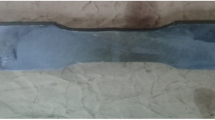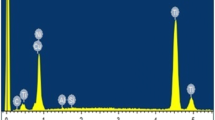Abstract
Type 316 LN stainless steel is the major structural material used in the construction of nuclear reactors. Activated flux tungsten inert gas (A-TIG) welding has been developed to increase the depth of penetration because the depth of penetration achievable in single-pass TIG welding is limited. Real-time monitoring and control of weld processes is gaining importance because of the requirement of remoter welding process technologies. Hence, it is essential to develop computational methodologies based on an adaptive neuro fuzzy inference system (ANFIS) or artificial neural network (ANN) for predicting and controlling the depth of penetration and weld bead width during A-TIG welding of type 316 LN stainless steel. In the current work, A-TIG welding experiments have been carried out on 6-mm-thick plates of 316 LN stainless steel by varying the welding current. During welding, infrared (IR) thermal images of the weld pool have been acquired in real time, and the features have been extracted from the IR thermal images of the weld pool. The welding current values, along with the extracted features such as length, width of the hot spot, thermal area determined from the Gaussian fit, and thermal bead width computed from the first derivative curve were used as inputs, whereas the measured depth of penetration and weld bead width were used as output of the respective models. Accurate ANFIS models have been developed for predicting the depth of penetration and the weld bead width during TIG welding of 6-mm-thick 316 LN stainless steel plates. A good correlation between the measured and predicted values of weld bead width and depth of penetration were observed in the developed models. The performance of the ANFIS models are compared with that of the ANN models.











Similar content being viewed by others
References
M. Vasudevan: Ph.D. Dissertation, Indian Institute of Technology, Chennai, India, 2007.
M. Vasudevan, A.K. Bhaduri, and B. Raj: Proc. International Institute of Welding- International Congress, Chennai, India, 2008.
Y.M. Zhang: Real time weld process monitoring, Wood Head Publishing, Cambridge, UK, pp. 74–103, 191–93.
S. Chockalingham, M. Vasudevan, and N. Chandrasekhar: Lecture Notes in Computer Science, K. Deb, ed., Simulated Evolution and Learning, LNCS 6457, 2010, pp. 270–78.
R. Kovacevic, Y.M. Zhang, and S. Ruan: J. Eng. Ind. ASME, 1995, vol. 117, no. 2, pp. 210-22.
R. Kovacevic and Y.M. Zhang: J. Manuf. Sci. Eng. ASME, 2007, vol. 119, no. 2, pp. 161-69.
G.E. Cook, A.M. Strauss, D.H. Lammlein, and P.A. Fleming: IOM3, 2008, pp. 15–41.
R. Fenn: Weld. J., 1985, vol. 64, pp. 18-22.
R. Fenn: British Journal of NDT, 1989, vol. 31, pp. 82-86.
J.S. Smith and W. Lucas: Welding in the World, 1999, vol. 43, pp. 10-22.
Y.M. Kwak and C. Doumanidis: ASME, Pressure Vessels and Piping Division, PVP 396, 1999, pp. 241–48.
B. Chan, J. Pacey, and M. Bibby: Can. Metall. Q., 1999, vol. 38, no. 1, pp. 43-51.
N.M. Nandhitha, N. Manoharan, B.S. Rani, B. Venkataraman, M. Vasudevan, P.K. Sundaram, and B. Raj: Int. J. Intell. Inform. Process., 2009, vol. 3 (2), pp. 271–79.
P. Ghanty, M. Vasudevan, D.P. Mukherjee, N.R. Pal, N. Chandrasekhar, V. Maduraimuthu, A.K. Bhaduri, P. Barat, and B. Raj: Science and Technology of Welding and Joining, 2008, vol. 13, no. 4, pp. 395-401.
P. Ghanty, S. Paul, D.P. Mukherjee, M. Vasudevan, N.R. Pal, and A.K. Bhaduri: Science and Technology of Welding and Joining, 2007, vol. 12, no. 7, pp. 649-58.
J.E.R. Dhas and S. Kumanan: J. Sci. Ind. Res., 2007, vol. 66, pp. 335-38.
K. Pal and K.S. Pal: Int. J. Manuf. Res., 2011, vol. 6, no. 1, pp. 15-29.
P. Ghanty, S. Paul, A. Roy, D.P. Mukherjee, R.N. Pal, M. Vasudevan, H. Kumar, and A.K. Bhaduri: Science and Technology of Welding and Joining, 2008, vol. 13, no. 2, pp. 167-75.
K.N. Gowtham, M. Vasudevan, V. Maduraimuthu, and T. Jayakumar: Metall. Mater. Trans. B, 2011, vol. 42B, pp. 385-92.
Author information
Authors and Affiliations
Corresponding author
Additional information
Manuscript submitted May 27, 2011.
Rights and permissions
About this article
Cite this article
Subashini, L., Vasudevan, M. Adaptive Neuro-Fuzzy Inference System (ANFIS)-Based Models for Predicting the Weld Bead Width and Depth of Penetration from the Infrared Thermal Image of the Weld Pool. Metall Mater Trans B 43, 145–154 (2012). https://doi.org/10.1007/s11663-011-9570-x
Published:
Issue Date:
DOI: https://doi.org/10.1007/s11663-011-9570-x




